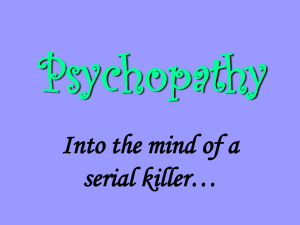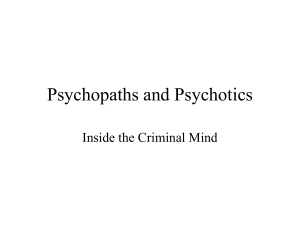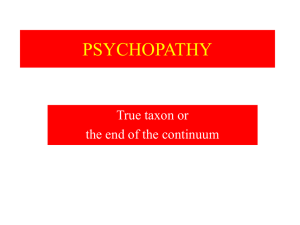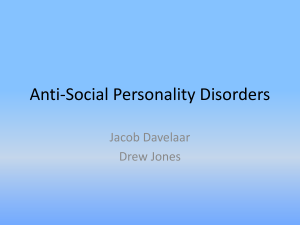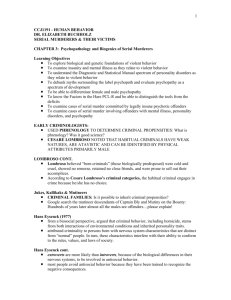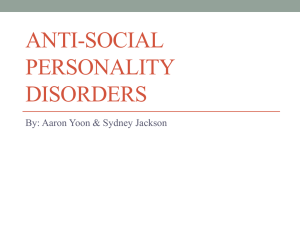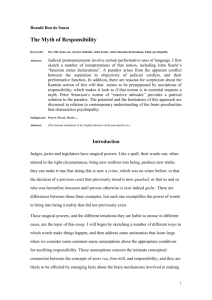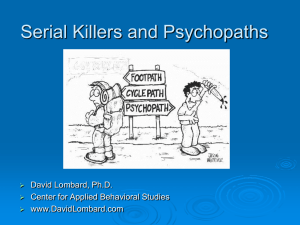Unit 3 Final Paper
advertisement
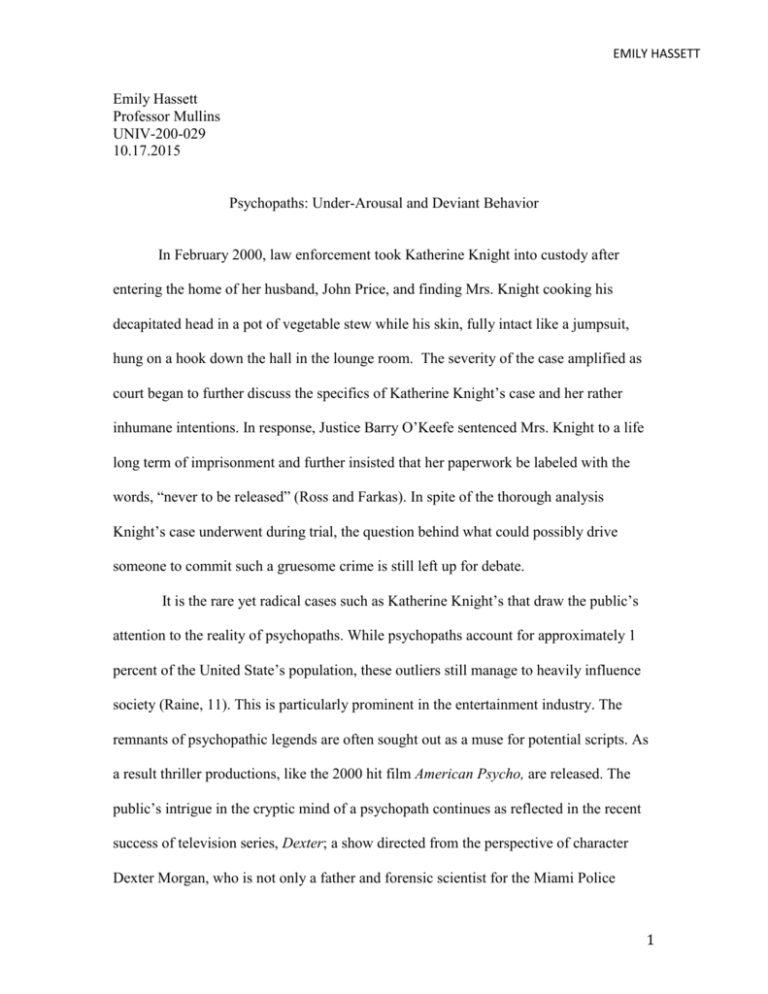
EMILY HASSETT Emily Hassett Professor Mullins UNIV-200-029 10.17.2015 Psychopaths: Under-Arousal and Deviant Behavior In February 2000, law enforcement took Katherine Knight into custody after entering the home of her husband, John Price, and finding Mrs. Knight cooking his decapitated head in a pot of vegetable stew while his skin, fully intact like a jumpsuit, hung on a hook down the hall in the lounge room. The severity of the case amplified as court began to further discuss the specifics of Katherine Knight’s case and her rather inhumane intentions. In response, Justice Barry O’Keefe sentenced Mrs. Knight to a life long term of imprisonment and further insisted that her paperwork be labeled with the words, “never to be released” (Ross and Farkas). In spite of the thorough analysis Knight’s case underwent during trial, the question behind what could possibly drive someone to commit such a gruesome crime is still left up for debate. It is the rare yet radical cases such as Katherine Knight’s that draw the public’s attention to the reality of psychopaths. While psychopaths account for approximately 1 percent of the United State’s population, these outliers still manage to heavily influence society (Raine, 11). This is particularly prominent in the entertainment industry. The remnants of psychopathic legends are often sought out as a muse for potential scripts. As a result thriller productions, like the 2000 hit film American Psycho, are released. The public’s intrigue in the cryptic mind of a psychopath continues as reflected in the recent success of television series, Dexter; a show directed from the perspective of character Dexter Morgan, who is not only a father and forensic scientist for the Miami Police 1 EMILY HASSETT Department but also an active serial killer who refers to his need to kill as his “dark passenger,” (Hall). The series Dexter wrapped up its season finale with 2.8 million viewers and a sweeping average of 6.4 million viewers across all media platforms (Hall). Experts in psychology have worked to accurately delineate psychopaths; however, the output produced by the world of entertainment has essentially led to a secondary definition of the term. Moreover the definition constructed by media output not only implements a faulty stereotype, which presumably is adopted by their audience, but there are also strong correlations between media and the activity, specifically criminal behavior, conducted by psychopaths. The relation between media and psychopaths emphasizes two key points. First, the influence that simply the mere notion of a psychopath has on society; and second, the need to reinforce the clinical definition of a psychopath in order for the public to recognize that psychopaths are not a product of fiction but existing beings in society. These tendencies are most apparent in the United States. The United State’s vulnerability to the two points previously addressed is directly expressed in global criminal statistics that report 85% of the world’s serial killers are produced in the U.S. (Schmid). Society is so quick to neglect the 1 percent of the population; however, the psychopaths creating this 1 percent are also accountable for twenty-five percent of the nation’s criminal behavior and thus making up a quarter of the total prison population (Raine,11). Nonetheless, psychopaths obtain a set of traits allowing them to easily adapt and progress throughout society. Regardless of psychopaths’ high prevalence among inmate population, the statistic does not enact for the full scope of psychopathic behavior. In other words, not all psychopaths are criminals. Some psychologists concentrated on the 2 EMILY HASSETT study of psychopathic and antisocial behavior, such as expert Paul Rabiak, have performed studies giving way to strong assertions about a ratio of one psychopath per twenty-five business leaders (Szalavitz). In short, the people are quick to associate psychopaths with fiction before recognizing that psychopaths are active members within community and in no way confined the stereotypes devised by society. Moreover, if an individual’s personality attributes superficial charm, a grandiose sense of self-worth, proneness to boredom, pathological lying, manipulative tendencies and a lack of remorse then that person can, clinically speaking, be classified as psychopath (Barlow, 454). Although psychologists have established a distinct set of criteria for defining a psychopath, there is still debate over what exactly drives psychopaths’ aggressive behavior. However, based on the insight provided by using the multidimensional approach to psychological disorders, psychopaths’ violent behavior is primarily driven by low arousal. BACKGROUND The multidimensional approach is an integrative model of analysis that incorporates all core psychological perspectives in order to construct a clinical overview of a disorder. The core perspectives include biological, psychological, cognitive, emotional and social analyses. Disorders often result from a combination of factors and therefore, it is crucial to test an inquiry against the full scope of study rather than clinging to one dimension. In regards to this discussion, when analyzing the under-arousal among psychopaths and how it incites deviant behavior, all dimensions of psychology will be taken into consideration. Moreover, the Diagnostic and Statistical Manual of the American Psychiatric Association, commonly known as the DSM-IV, is the product of integrated or multidimensional reasoning (Barlow, 65). The DSM-IV not only organizes 3 EMILY HASSETT all disorders relevant to the psychological field but also is the clinical description guide used universally by experts to identify and diagnosis disorders. The classification within the DSM-IV itself can reveal vital insight of a disorder. Along the perpetual continuum of psychopathology, the scientific study of mental disorders, psychopathy falls within personality disorders. More specifically, psychopaths are grouped in cluster B, a category of personality disorders that stem from abnormalities in erratic and emotional behavior. This cluster includes borderline, histrionic, narcissistic and antisocial personality disorder. Psychopathy is closely associated with antisocial personality disorder and the terms are frequently used interchangeably. This being that both personalities are identified by impulsive and deceitful behavior, accompanied with a lack of remorse, an inability to comply with social norms, and a habit of violating the rights of others. Psychopaths’ personalities and mindsets are very distinctive compared to the rest of the population. After thorough analysis of psychopathic cognition, psychologist Raine, describes a psychopath as someone who, “see others as little more than emotional, physical, financial prey, and feel justified in their belief that the world is made up of ‘givers and takers’ and that they are natural born ‘takers’,” (11). The classification is an effective way of identifying and diagnosing psychopathy, as well as, recognizing what it is not. Prior to taking the integrative approach to the analysis of drives psychopathic behavior, it is important to address common misconceptions. Contrary to popular belief, psychopaths are in no way psychotic. That is, psychopaths are completely rational and fully aware of society’s standards of right and wrong. Furthermore, psychopaths’ sense of entitlement and their conscious decision to 4 EMILY HASSETT act against society’s standards anyway is a defining attribute of the disorder. Hence, psychopaths are in touch with reality yet deviate from the social norm due to personality deficits. THE LOW AROUSAL THEORY To pinpoint a key element responsible for fueling psychopathic behavior is virtually the same as identifying the motive behind psychopaths’ engagement in thrillseeking and generally violent activities. Conjointly human motives are strongly linked to arousal; thus, directing the discussion towards the low arousal theory. Preceding the inquiry on under-arousal among the psychopathic community, the Yerkes-Dodson curve was introduced to illustrate the pragmatic relationship between arousal and performance. The curve, developed by well-respected psychologists Robert Yerkes and Dillingham Dodson, indicated that “intermediate levels of arousal” are shown to be most effective in regards to an individual’s performance (Barlow, 454); performance referring to all situational context. Being that moderate levels of arousal are ideal, the extremes both low and high levels correlate to “negative affect” and “poor” performance (Barlow, 454). The Yerkes-Dodson curve is the sole structure for the low arousal theory. The low arousal theory is based on the premise that psychopaths’ depressed arousal rate, relative to the Yerkes-Dodson curve, is the underlying factor that ignites psychopaths’ impulsive and perverse behavior. Illicit episodes provide extreme heights stimulation; further, extreme sources of elevation are necessary to temporarily boost psychopaths’ chronically low arousal rate (Barlow, 454). THE FEARLESSNESS THEORY Experts that are skeptical of the low arousal theory are generally more in favor of the fearlessness theory. The fearlessness theory is centered on psychopaths’ high tolerance to fear stimulating events. Thus, this theory concludes that psychopaths’ 5 EMILY HASSETT devious behavior is the result of their resistance to fear (Barlow, 454). While the notion that psychopaths are more resistant to fear inducing stimuli than the average being is an accurate assumption; however, the theory does not adequately target what element initiates psychopathic behavior. For example, put the fearlessness theory into context for said actions of Katherine Knight in case previously introduced. Fearlessness theorists would suggest that Katherine Knight’s lack of fear is what most accurately depicts why she decided to kill, skin, and decapitate her husband, John Price. Mrs. Knight’s lack of fear may have enabled her to follow through with the murder of her husband yet that is all it explains. Her resistance to fear aided her to carry out said actions but to say Knight’s fearlessness was the primitive element that incited her murder is a weak claim. With all things considered it is likely that fearlessness is merely a companion trait to psychopaths’ diminished arousal response. DEVELOPMENT There is no single factor that dictates whether or not an individual falls victim to psychopathy. Furthermore, it is the early stages of development that are conclusive to inducing or potentially deterring psychopathy within an individual. For example, a child may have inherited antisocial attributes; however, psychopathy will not arise unless those genetics are met with environmental aspects that also induce psychopathy, such as physical abuse or trauma. Accordingly, a variety of factors heavily influence a person’s liability to onset psychopathic behavior including biology, environmental and psychological circumstances. The biological dimension of psychopathology is fixed on what genetic factors tailor to a specific disorder. In other words, genetics are the innate predisposition of psychopathy. Moreover, the influences of genetics are particularly unique to psychopaths 6 EMILY HASSETT as suggested by James Blair, doctor of Psychology, who stressed that,” no biologically based disorder other than psychopathy is associated with an increased risk of instrumental aggression,” (155). Within the realm of biological influences there is neurological makeup. The study of brain structure is significant in the course of understanding psychopaths. After all, the early stages of development are critical due to the parallel maturing of the brain structure or lack thereof. This is where the environmental circumstances partake in a major role; certain features of environment are capable of handicapping or stunting brain maturity in children undergoing development. Environmental stressors such as, “consequence of abuse,” can physically, “breakdown hippocampal functioning,” (Blair, 35). That is, external variables are the turning point that takes biological impairments and solidifies them into seemingly permanent emotional and affective deficits (Raine, 7); evidently, the deficits adopted during development enact for psychopaths’ chronically low arousal. NEUROLOGICAL EXPLANATIONS Neurological evidence has opened insight to several major components of psychopathy. First, the evidence reflects the lack of responsiveness or neural activity, which confirms the diminished arousal rates of psychopaths. Second, brain imaging has allowed neurologists to determine what structures of the psychopathic brain are abnormal. Finally neurology can analyze psychopaths’ decision-making and draw connections between their actions and neurotransmitter imbalances. A study done in 2012 by clinical psychologist, Drislane, tested arousal in psychopaths’ by measuring their cortisol levels and thereby measuring their response to stimuli. Drislane’s procedural report used electroencephalography to determine the subjects P3 response; the subjects were each shown “18 pleasant, 18 neutral, and 18 7 EMILY HASSETT unpleasant IAPS scenes” (828). The subjects’ emotional sensitivity or cortical levels were recorded after each of the stimuli encounter. Drislane reported that the psychopaths within the group of subjects, had significantly lower response rates to stimuli than the remaining participates; A lack of response or lower amplitude rate is a representation of diminished cortical levels or affective features, which corresponded with the results of the psychopaths (Drislane, 834). In addition, regarding that low arousal is able to drive psychopaths to commit such violent and aggressive behaviors is further supported by evidence regarding what type of classified emotions do offer motive to psychopaths. Psychologists, Sherrie Williamson, Robert Hare, and Stephen Wong developed a study centered on answering whether psychopathic criminals inflict more harm on their victims than do other criminals. The researchers hypothesized that due to psychopaths’ proto-emotional drive, they are involved in less “crimes of passion” (456). Furthermore they anticipated that being that psychopaths do not genuinely value interpersonal relationships, if a significant portion of psychopathic crimes are not “crimes of passion” then their victims are less often family or friends. Williamson, Hare, Wong observed that of the 630 participants, half being psychopaths as diagnosed by Hare’s Revised Psychopathy Checklist, 45% of the psychopaths had committed crimes driven by material gain compared to the 14.6% of the non-psychopaths (460). This study reflects how psychopaths’ lack interpersonal relation and instead psychopaths are fixated on egocentric and self-rewarding ways. Furthermore, it introduces the notion of proto-emotions. This heavily coincides with the low arousal theory. Clinicians have begun to shift their focus away from the notion that psychopaths’ impulsive episodes are triggered by strong emotions; furthermore research 8 EMILY HASSETT has suggested that, “violent and aggressive acts by psychopaths are often motivated by proto-emotions, such as tension or frustration, or by weak emotions breaking through even weaker restraints, rather than by strong emotions such as fear or anger,” (Williamson, 455). Essentially it is the weaker emotions that trigger psychopaths’ need to seek thrilling and illicit behavior to boost their flat rate of arousal. Whether or not psychopaths’ are consciously aware that they are seeking stimulation, under-arousal does not satisfy and therefore, psychopaths will be urged to raise arousal levels even if it requires devious actions or inflicting harm on others. The neurological evidence coincides with psychopaths’ interpersonal behavior or lack of. As previously mentioned, early develop enacts for psychopaths emotional and interpersonal deficits that go hand in hand with under-arousal. Psychopaths’ lack of impulse control and narcissistic attitude are linked to neurotransmitter imbalances within the brain (Perez, 521). The reasoning behind psychopaths’ need to go to extreme violent behavior is partially because they are unable to take part in emotional relations with other. Interpersonal relations are one of the most prominent sources of arousal for humans being that we are social beings. However, psychopaths’ who are unable to form meaningful attachments do not develop an understanding of recognizing their own mental states, let alone the mental state of others (Perez, 520). The inability to form healthy interpersonal relationships is very detrimental to psychopaths. Moreover, psychopaths’ lack of interpersonal clarification even influences their speech; rarely do psychopaths’ choose words regarding any sort of affection, “instead they process and use them primarily in terms of denotative, dictionary meanings. It is as if emotion is a second language,” (Raine,11). 9 EMILY HASSETT CONCLUSION In summary, regarding the low arousal rate present in psychopaths as the fundamental drive behind their violent and aggressive tendencies will allow for immense progress in the understanding of psychopathy. As discussed, the element of diminished or restricted arousal is a crucial aspect that is the primary drive behind their deviant behavior. This shift in interpretation not only opens gates to a better understanding of the characteristics of a psychopath but is also a slight variation that has the potential to significantly shape the structure of succeeding research studies. In an ideal world, experts in the psychology field would begin applying this the low arousal theory not just to behavioral studies but also the overall diagnosis process. Nonetheless, given the realities of the situation this notion will be a minor yet critical shift in research direction seen in future studies as well as possibly the restructuring of past studies to produce more beneficial evidence. Furthermore, this approach has the potential to significantly impact the discussion and analysis of present evidence along with any following evidence produced. To retract and continue the sentiment of an ideal world, these studies would put an overall emphasis on the importance of being clinically accurate when conceptualizing psychopathy to general public. Being the movie and television industries are hugely rewarded for their success in producing horrifying yet captivating scripts on fictionalized psychopaths, it is highly unlikely to enforce ethical standards regarding psychological accurateness on public entertainment. Although, the ethical standards currently established and supposedly applied to journalism and news reporters could undergo changes that are tailored to the concept discussed. Furthermore, understanding the emotional deficit in psychopaths as their fundamental drive is a significant turning point in the current research presented on the correlation between 10 EMILY HASSETT psychopathic behavior and media coverage. There is a clear relationship between violence and media that’s evident in psychopathy; thus, the shift in the psychological field should be followed up in the ethical policies enforced on news related media, which in the long run could prevent future incidents and potentially raise accurate awareness rather than depict personality disorders in gruesome ways. In short, the concept that under-arousal within psychopaths is triggers the need for psychopaths to conduct violent or high stimulating behavior in order to boost their chronically low levels of arousal, is a notion that could potentially redirect the psychological world to a more beneficial understanding of prevention and treatment. Applying this perspective to the clinical and psychological studies has a ripple effect that is bound to broaden the scope of psychopathic cognition as well as what triggers their violent behavior. While this opts for a shift in focus in the world of psychopathy, its contributions are well worth it in regards to better understanding psychopaths, successfully treating the clients, and gaining insight on predicting and preventing violent episodes. 11 EMILY HASSETT Work Cited Barlow, David H., and Vincent Mark Durand. "Personality Disorders." Abnormal Psychology: An Integrative Approach. 7th ed. Cengage Learning, 2015. 30-45, 443-454. Print. Blair, James, Derek Mitchell and Karina Blair. “The Psychopath: Emotion and the Brain.” Blackwell Publishing. (2005): 47-66. Print. Drislane, L.E, U. Vaidyanathan and C.J. Patrick. “Reduced Corticl Call to Arms Differentiates Psychopathy from Antisocial Personality Disorder”. Psychological Medicine. Cambridge University Press. (2012): 825-835. Web. 17 Sept. 2015. Hall, Michael. Dir. “Dexter”. Paramount Home Entertainment, (2013). Film. Greene, Joshua, and Jonathan Haidt. “How (and Where) Does Moral Judgment Work?” Trends in Cognitive Sciences. Vol. 6 No. 12 (2002): 517-523. Web. 17 Sept. 2015. Perez, Pamela. “The Etiology of Psychopathy: A Neuropsychological Perspective.” Aggression and Behavior. Vol. 17. (2012): 519-522. Web. 17 Sept. 2015. Raine, Adrian and Jose Sanmartin. “Psychopaths and Their Nature: Some Implications for Understanding Human Predatory Violence.” Violence and Psychopathy (2001): 5-34. Print. Ross, Reid and Ivan Farkas. “Six Real Serial Killers More Terrifying than any Horror Movie.” Cracked. (2013). Web. 9 Nov. 2015. Schmid, David. "Serial Killers and the Hollywood Star System." Natural Born Celebrities Serial Killers in American Culture. Chicago: U of Chicago, 2005. Web. 16 Sept. 2015. Szalavitz, Maia. “Study: 1 in 25 Business Leaders May Be Psychopaths.” The Time. N.p.(2011). Web. 9 Nov 2015. Williamson, Sherrie, Robert Hare and Stephen Wong. “Violence: Criminal Psychopaths and their victims.” Canadian Journal of Behavioural Science. Vol 19.4 (1987): 454-462. Web. 16 Sept. 2015. 12
